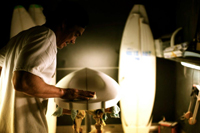
photo by ryo-shimizu.com |
Ben Wei
1976.4.1生まれ。
サーフボードのシェイパー歴20年。カボ サン ルーカスでスタートし、
メキシコ、カリフォルニアのオーシャンサイドでキャリアを積む。
現在は千葉から、1999年より続ける自身のブランド『5050 Waveskates』を展開し、
日々新たなボードデザインを探求している。
エクスクルーシブモデルとしてLazyBoySkillの"Sex Machine, and CoreFighter"、
Zburhの"Waveskate"、"Upload"をシェイプ。8年間Gravity Skateboards teamに所属。
プロサーフチームのライダーの田中英義、森大樹、田嶋鉄平、加藤嵐、Zucchoらと共に、
サーフクロストレーニング用のスケートボード"Twist"をスタート。
音楽マニアで、"Jackson884"というバンドのトラックメーカー。
KORGの新しいVolca Synthesizersのプロモーションビデオも手掛ける。
スポンサー : Moon Jelly Wetsuits, INSP Clothing, GreenFix Wax, FCS,
Gorilla Grip,
Canvas Shoes, KORG, Yamaha Motors Japan, and Skull Candy. |
| 1回目 |
2013/10/2 |
『Choosing the right board for you』 |
| 2回目 |
2013/10/16 |
『Choosing the right board for you 2』 |
| 3回目 |
2013/11/6 |
『Board construction options』 |
| 4回目 |
2013/11/20 |
『Board Rhythm, matching your board to music
(Surfing through a musical perspective).』 |
|
『Choosing the right board for you(正しいボードのチョイス)』
スタイルやスキル、スタンス、そして、いつも乗る波のサイズにフィットするボードに乗るだけで、
きみはサーフィンのレベルを変えることができる。
多くの人がどんなボードに乗るべきなのか悩んでいると思う。
もし、雑誌でプロのサーファーたちが何のボードに乗っているかを気にしながら選んでしまうと、
間違った方向へ行ってしまうだろう。
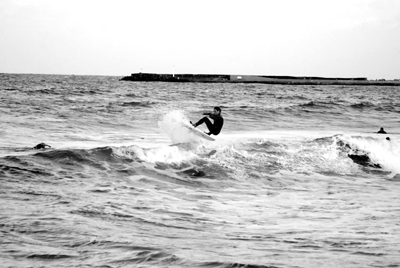 photo by ryo-shimizu.com photo by ryo-shimizu.com
たいがい、プロたちは僕らよりも全然高いレベルでサーフィンをしていて、
彼らはどんなボードであろうとも上手くサーフィンができるということを覚えておこう。
もちろん、お気に入りのプロのライディングに似たようなこともできるはずだ。
だけど、そのボードは君のレベル、体型に合わせられていて、
そして最も大切なことは、そんな時は、普段、日常的にサーフィンをしているような波においてなんだ。
プロたちが乗る波はパワー、スピード、サイズともにワールドクラスの波だ。
おそらく、僕らが普段、毎日乗る波とは全然違う波だろう。
彼らのボードはこのような良い波のためにデザインされていて、
僕らが普段乗るコンディションで使ったとしても、本来のパフォーマンスを発揮しないんだ。
オーストラリアのシェイプは、オーストラリアの波にベストなように作られている。
ハワイのシェイプはハワイのコンディションに、
カリフォルニアは日本に近いコンディション用に作られているけど、それでも少し違う。
だけど、幅、厚み、ロッカー、レールをいくらか調整するだけで、
僕らが乗る普段の波でも走るボードができる。
いくつか重要なポイントを挙げてみると...
幅:安定するように、レールからレールまでの幅を増やし、
小さいサイズの波、もしくはハイタイドにも対応できるようにスライドしやすいように味付けする。
普段のコンディションの場合、多くのトッププロたちは3年前のボードより約3/4インチ幅の広く、
4~5インチ短いボードに乗っている。
こうすることで、より速いスピード、より高いエアー、より早い回転性を得ることができる。
厚み:厚みを増すことで、パドリングをしやすくなり、早くテイクオフできる。
波のフラットな場所でもスピードを持続させることができて、
アウトからインサイドまで乗りつなげやすくなる。
長さ:全てのボードスポーツにおいて言えることだけれども、短いボードはより操縦性を得ることができる。
下手に短くすると不安定になるけど、スイングしたときの“感じ”を調整することで
ボードの上でバランスを保てるようになる。
幅と厚みをより増してボード全体でバランスことによって、より短くすることが可能だ。
目安でいうと、1/2インチ幅を広くし、2~3インチ短くできる、
もしくは、1"幅を広くすれば、4~5インチ短くできる。
ロッカー:おさえめのロッカーはスピードをアップさせ、滑らかに滑ることができる。
強いロッカーは機動性が向上し、掘れて切り立った波に効果的だ。
しかしフラットな波ではスピードが遅く、水をプッシュし、スピードダウンさせてしまう。
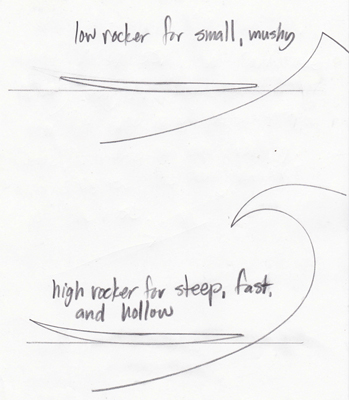
幅のポイント:ボードの一番幅の広いポイントは前足に近くてはいけない。
もし、ワイドスタンスで幅の広いポイントが下がっている(ほとんどのプロの板のように)ので
あれば、踏み込んでノーズを水につけるようにしてしまい、スピードをダウンさせている。
もし、狭いスタンスで幅の広いポイントが前に離れ過ぎている場合は、
ノーズが水から上がりすぎて、レールからレールの動きを鈍らせてしまっている。
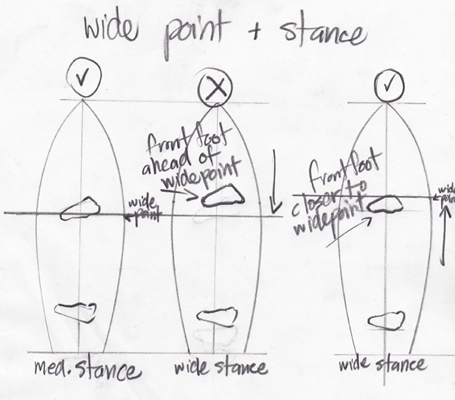
ボトムコンケーブ:たいがいの細い幅のボードは深いシングルのコンケーブで持ち上げる力(揚力)を得て、
レールtoレールが身に付いているサーファーにとって
高いレベルのパフォーマンスを得ることができる。
もし、ハイスピードでレールでターンをしない人が乗ってしまうと、
張り付いた感じになり、簡単にレールが食ってしまう。
幅の広いボードはすでに接水面が多く、スピードを生み出すので
深いコンケーブは必要としない。
幅の広いボードに対する深いコンケーブは、レールからレールの動きを遅くし、
コントロールがより難しくなる。
幅の広いボードは浅めのコンケーブがベストだ。
“ダブルバレルコンケーブ”はそれぞれのボトム面が水に直接触れることで、
レールからレールの動きを遅くさせずに、スピードを得ることができる。
フィン:ツインフィンはフラットな波において良くスピードを持続させ、フィンベース(幅)、
もしくはフィンの表面からスピードを生んでいる。
しかし、高さ/ベース(幅)/表面を増やしたフィンはレールからレールの動きを遅くしてしまう。
単純にクルーズしたい、波をグライドしたいという前足に重心を置くようなサーファーにとっては
一番良いと思う。
掘れた波や高い操縦性を求めるのには向いていない。
シングルフィン:シングルフィンはフィンの高さのおかげでとても安定している。
細身でフレックスするシングルフィンは
とてもスピードに乗った持続的なフィーリングがある。
シングルフィンは長いストレートラインを滑るには良いが、急な動きは厳しい。
フィンの長さによって、レールからレールの動きを難しくさせる。
トライフィン/スラスターズ:トライフィンはいいバランスのドライブ、素早いレールの動き、
急激な操縦に優れている。トライフィンはロー/ハイスピード、
またどんなコンディションにも対応できる。
クアッド:2本のフィンを、両サイドフィンにさらに付けたクアッドは力強いドライブ性を持ち、
掘れた波に優れている。
しかしフラットな波や満潮時は、4つのフィンが水に着いてしまい、
乱れや引っ張りが起こり、スピードがダウンしてしまう。
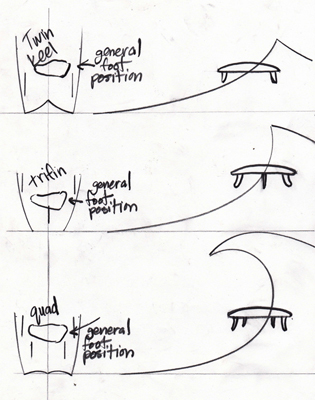
きみにとってパーフェクトなボード選びをすることによって、もっとサーフィン楽しむことができる。
そしてそんなボードは、次のレベルにきみを連れて行ってくれるはずだ。
知ってもらいたいのはプロに通用することではなく、きみに通用することが大事であるということ。
きみのボードは駐車場ではかっこよく見えるかもしれないが、水の中でのパフォーマンスは・・・。
もし、きみがサーフィンする時に笑顔になれないようであれば、
もしかしたら、きみが乗っているボードを変える必要があるかもしれないね...
ありがとう!!! ベン・ウェイ(5050Waveskates)
--------------------------------------------------------------------------------------------------------------
Choosing the right board for you
by Ben Wei
By riding a board that fits your style, ability, stance, and the waves that you usually ride, you can change your level of surfing.
Too many people are confused with what they should be riding.
If you pay too much attention to what the pros in the magazines are riding, you may be on the wrong track. remember that the pros surf at a higher level than most of us, and they can surf well on almost anything.
Of course you can ride something similar to what the your favorite pros ride, but it should be adjusted to your surfing level, body size and weight, and most importantly, the waves that your normally surf.
First look at the waves that the pros are riding, usually world class waves, with power, speed and size.
Probably a lot different than the waves that you usually surf everyday.
Those board designs are made for good waves, and if you use them on our everyday conditions, they won't perform the way that they should.
Australian shapes are usually best for Australian waves, Hawaiian shapes are made for Hawaiian conditions, and California shapes are made for conditions close to what we ride here in Japan, yet still different.
However, with some adjustments to Width, thickness, rocker, and rails, they can work well in our everyday wave conditions.
Here are some important points to pay attention to…
Width : Width increases the boards rail to rail stability, and adds slide in small or high tide conditions.
For everyday conditions, many top pros are riding boards that are about 3/4" wider, and 4-5" shorter than what they rode three years ago. This has allowed them to more speed, do higher airs, and faster rotations.
Thickness : Adding thickness will make paddling easier, take offs earlier, and help carry your speed through flat spots on the wave, and making the connection between the outside and inside in most spots.
Length : As in every other board sport, we have all discovered that going shorter in length, gives you more maneuverability, by taking away (swingweight), it also balances your weight more evenly over the board.
By adding more width, and thickness, you can take away the length.
1/2" wider - 2-3" shorter, 1" wider - 4-5" shorter etc…
Rocker : Lower rocker increases speed, and glide.
High rocker is to increase maneuverability, and fit in critical, vertical, points on the wave. However, in flat surf, and at lower speeds, it pushes water, and slows you down.
Wide point : The boards widest point , should be close to your front foot.
If you have a wide stance, and the wide point is set back (like most pros' boards), you will be pushing the nose into the water,and slowing yourself down.
If you have a narrow stance , and the wide point is too far up, the nose will ride high on the water, and slow down your rail to rail response.
Bottom Concave: Most narrow width boards use a deep single concave to provide lift and drive, and work best for high level, rail to rail surfers, if they are not turn on rail at high speed (flat turning), they are sticky, and dig rail easily.
Wider boards make speed from having more surface area, so deep concave is not necessary.
Deep concave on a wide board makes the rail to rail transition slower, and takes more effort.
Wider boards are best with light concave.
A double barrel concave will let you make speed, by directing the water on each half of the bottom, without slowing down the rail to rail transition.
Fins : Twin fins carry speed nicely on flat waves, and make speed from the increased fin base, or fin surface, however the increased fin Depth/Base/surface, makes the rail to rail transition slow.
They are best for forward stance surfers, that just want to cruise, and glide along smooth lines on the wave.
Not good for vertical, high performance maneuvers.
Single fins : Single fins are very stable because of the depth of fin.
With a narrow body, flexible single fin, The board can have a very nice alive feeling, they are good for long straight lines, but very hard to put on rail.
The depth of the long fin, makes the rail to rail transition very difficult.
Tri-fins/thrusters : The Tri-fin gives a nice balance of drive, quick rail to rail transition, and release for more radical maneuvers.
Tri-fins work best in all conditions, at low or high speeds.
Quad : Quads give great drive and hold on steep waves, when using the two fins on each side.
However, when the waves are flat or high tide, the four fins are in the water at the same time, they cause turbulence and drag, and slow the board down.
By choosing the perfect board for you, you can enjoy surfing more, with less effort, and take your surfing to the next level.
Remember that it's not what works for the pros, it's what works for you.
Your board may look cool in the parking lot, but it is your performance in the water that really matters…
If your board doesn't make you smile everytime that you surf, you probably need to change what you ride…
Thank you !!! Ben Wei (5050Waveskates)
|
